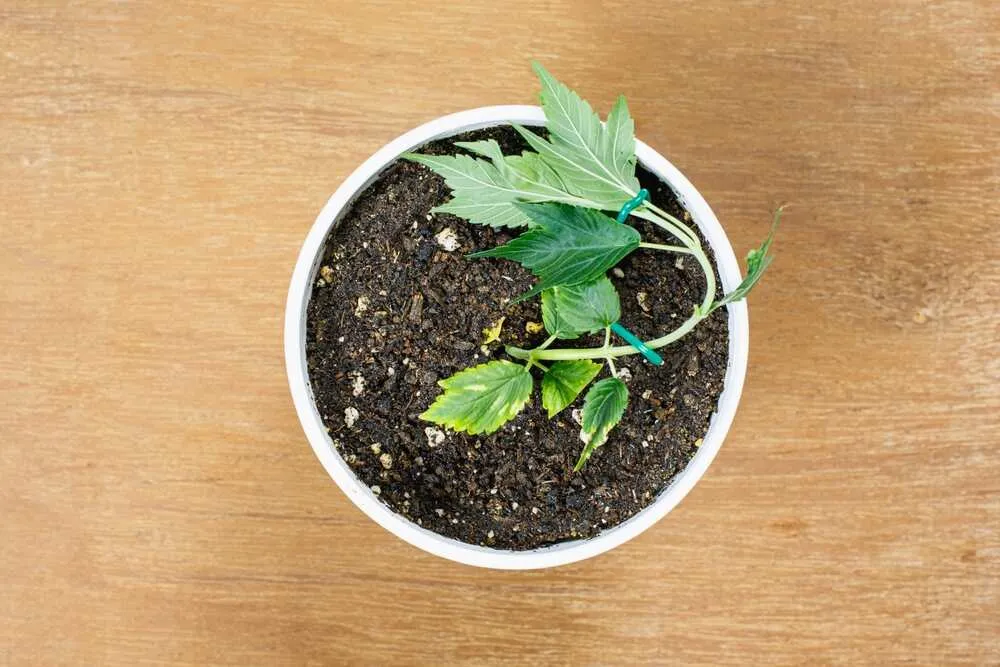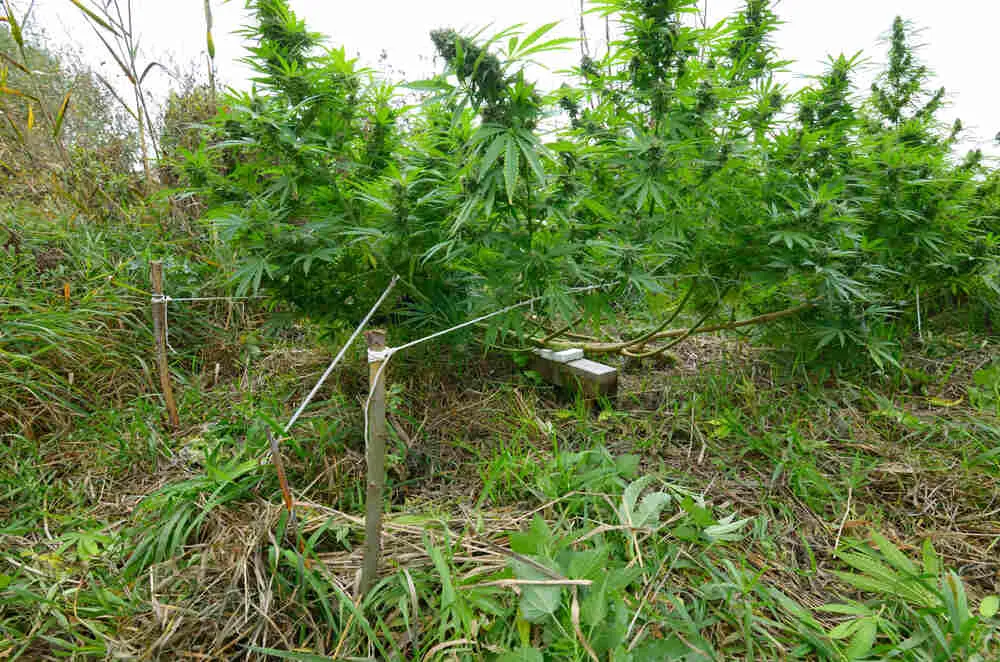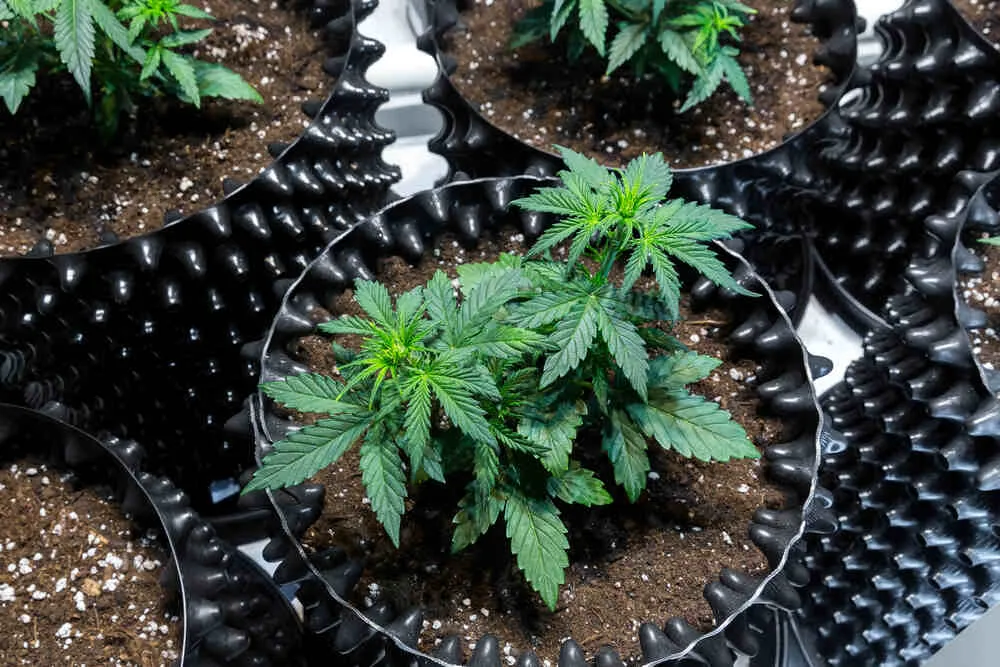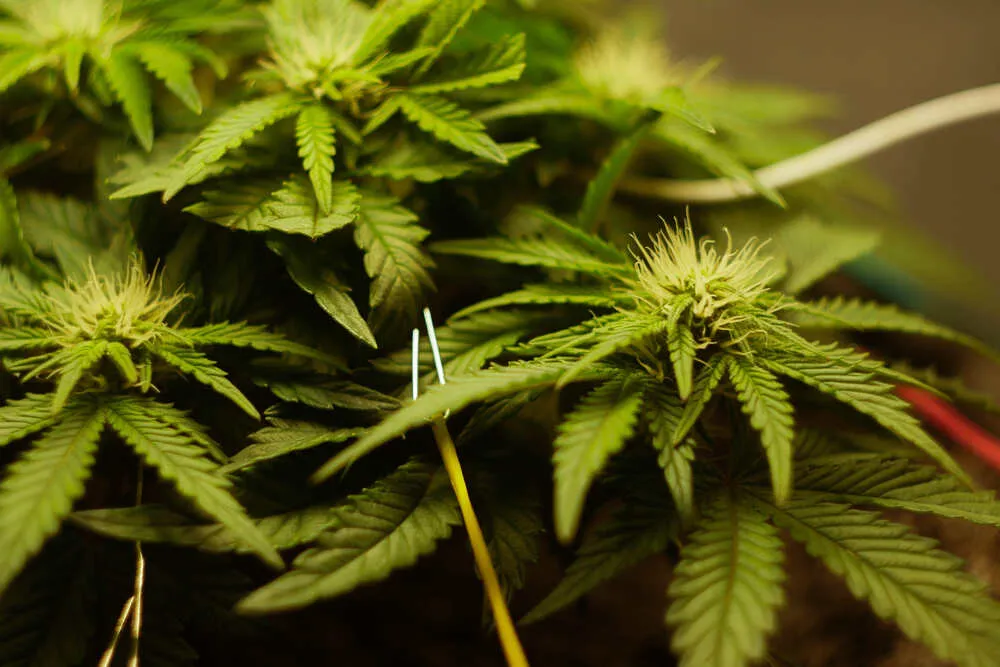Low-Stress Training (LST) Cannabis Step-By-Step

Low-stress training (LST) techniques are a set of plant training methods that can lead to better hormone distribution throughout the entire plant, which (when performed correctly) can boost the final yield by as much as 25%.
Cannabis plant training is a controversial subject throughout the cultivation landscape. Some growers swear by it, while others keep their distance. And while certain training techniques can and do impose heavy stress levels onto the plant, if you stick within the LST realm, and follow the guidelines correctly, then you really shouldn't have any issues whatsoever.
But what does LST involve exactly? Is it difficult to perform? And when should this form of training begin (and end)?
- What Is Low-Stress Training?
- The Tie-Down Technique
- Does LST training increase yield?
- Is It Better to Top or LST Cannabis Plants?
- What Is Topping?
- When Should You Start LST Training?
- How Long Should You LST Train For?
- Should I stop LST during flowering?
- Step By Step Guide on Low-Stress Training
- Can beginners do LST training?
- The Wrap Up
What Is Low-Stress Training?
While the idea of training a plant may seem above novice growers' paygrade, and a little daunting to the initiated, LST techniques are actually very easy to perform, and can produce brilliant results when implemented in the right way, and at the right time.
There are two main categories of plant training techniques - Low-Stress Training (LST) and High-Stress Training (HST). These categories are separated by how invasive the training producers are for the plant, and how much stress they impose. LST techniques are meant to help boost the overall yield and bud quality of your crop, without stressing it to the point that growth is stunted whatsoever. This makes LST techniques perfect for all cannabis varieties, autoflowering plants included.
As autoflowering cultivars have a predetermined vegetative growth period that cannot be adjusted, the last thing you want to do is overly stress them and cause the growth to slow down, even for just a few short days. With regular, everyday photoperiodic strains a short gap in growth is acceptable, as you only need to keep the lights set to 18 hours per day to force the plant to stay in vegetative growth - meaning you can easily make up for that lost time. The same goes for outdoor photosensitive crops, whose vegetative period is long enough that you really don't need to worry about a short break in plant development.
This is why using LST methods on autoflowering strains, and that photoperiodic strains should only go through high-stress training. Simply put, all forms of cannabis will benefit from LST, but you should only consider using HST techniques on photo strains, and once you have a decent amount of experience and understanding under your belt.
There are a couple of forms that low-stress training takes, the most common by far being LST via the tie-down method. This is the technique we will focus on in today's post, but be aware that is anything but the only way to train your cannabis plants while keeping the stress levels low. the other two LST techniques commonly employed include SCROG and SOG, but these methods deserve a whole post to themselves.
The Tie-Down Technique
The name has probably clued you into how you are going to move forward with this technique, but for the slightly slower stoners among us - This method involves using some sort of soft tie (garden ties, twine, even cable ties) to manipulate the normal growth pattern of a cannabis plant.
One slightly annoying issue that almost all cannabis varieties naturally develop is much heavier, denser, more resinous buds at the top of the plant, with the quality slowly but surely decreasing as you move further down. By tying down the main stem (and the subsequent branches) and forcing the plant out of its Christmas tree-like Apical dominance, and into a more horizontal shape, we can promote a much more even distribution of the main growth hormone Auxin, and the nutrients that are needed for proper, dense bud development.
This horizontal growth pattern not only helps with hormone and nutrient distribution but also with light penetration and canopy airflow. As the plant is forced to evenly spread its buds across the canopy, each budding site receives an equal amount of light which helps boost overall yields and increases resin production. The improved airflow that this method brings also helps keep temperatures down and a steadier and larger stream of fresh oxygen and C02 circulating around the developing flowers, further boosting yield and quality.
The tie-down technique has to be started early on in the plant's vegetative period (but not before the third node has fully appeared) and can be continued all the way up until the plant structure settles at around the third week of flower production, but more on the exact timing a little further on in this article.

Does LST training increase yield?
That's an impossible question to answer, as the exact yield increase is determined by a number of factors. LST in and of itself won't increase the yield exponentially - the overall success of LST depends on how skilled you are at performing the technique, the health of the plant before LST is undertaken, how long the LST process has been kept up for, the strain you are trying to train, the environmental conditions, and a range of separate but interconnected factors.
A better question to ask is -
How much CAN low-stress training techniques (such as the tie-down method) increase yields?
LST will, generally speaking, increase yield by a significant margin of around 10-25%. But again, results may vary. What can be said with a confident degree of certainty is that LST will always increase yield (when performed correctly), and sometimes even more than the figures mentioned above.
Just keep in mind - LST is not the be-all and end-all when it comes to increasing yield sizes and resin production. There is a wide range of techniques and methods used to boost yields and LST should be implemented as part of a larger strategy. When growing weed, its important to be able to
- Control the temperature and humidity of the grow room
- Use the best light source possible
- Filter the air, and ensure that the air exchange and canopy ventilation is appropriate
- Keep the grow tent or area spotlessly clean
- Provide the best quality nutrients, in the correct dosages, at the correct pH range
- Harvest at the perfect moment
That said, LST more than holds its own when it comes to helping increase yields and trichome coverage. And with LST being one of the easiest methods to successfully apply, we strongly suggest giving LST a go from the very first crop you grow, indoors or out.

Is It Better to Top or LST Cannabis Plants?
Again, this is a pretty difficult query to give an overarching answer to. There are just too many variables and factors at play, which can change the outcome of LST versus topping.
As mentioned above, autoflowering plants usually respond in a much more positive way to LST over HST techniques. So, should you never top autos? No, there are loads of experienced autoflower growers out there who have had great success with topping their autos, but this sort of training should be reserved for experienced growers who have a firm understanding of not just cannabis generally, but the specific strain itself.
Topping is probably the most common HST method used in marijuana cultivation - so, obviously, it has a time and place where it can outperform (or at least match) the results that LST techniques provide.
What Is Topping?
Topping is a technique used to create multiple main colas for the plant, instead of one large cola. To accomplish this, you will need to cut off (or “top”) the main stem of your cannabis plant above a node. This will cause the branches that are developing at the said node to become the two new mains stems, effectively doubling the number of main colas - and promoting more lateral growth from that point onwards.
Topping can be repeated multiple times, leading to an increase in the number of main colas and a more even canopy - resulting in a higher overall yield. But, every single time you top a plant, you put it under heavy stress. This stress will 100% cause a pause in the growth while the plant recovers. This pause could last from a few days up to more than a week.

So, which technique should you use?
Again, very hard to say. But if you are an experienced grower, and you have already run a crop with LST, then it might be time to combine the two. Topping and tying down cannabis plants works amazingly well together, as topping forces the plant into a more horizontal growth pattern, which can then be further enhanced with LST.
This combination of techniques will provide you with a plant that grows more laterally and produces multiple colas - with less stress on the plant overall.
When Should You Start LST Training?
This is the most hotly debated part of LST - when to start. Some growers like to LST from the start, while others wait until their plants have a good root system in place before they start LST training.
But, in our opinion, LST can be started as soon as your plant is big enough to tie down. LST cannabis training should be started as soon as you have 2 to 3 nodes. At this stage, the main stem is still very pliable while the root system has already begun to form a dense ball, making it the perfect time to start bending those ladies over. You don't have to go the whole hog from the very beginning. Start with a slight bend in the main stem and over the next week slowly pull her further into the horizontal plane.
Continue reading a little further down for the full LST tie-down method explained.
How Long Should You LST Train For?
Cannabis plants go through a few distinct growth stages. First up are the germination and seedling stage, but these are quickly over and done with. Next is the vegetative growth period, and this is where the plant structure develops, and the plant puts on most of her size. When growing photoperiodic plants indoors, cultivators can force the plant to stay in this growth stage by simply keeping the daily lighting schedule to 18 hours of light/6 hours of dark. Outdoor growers are at the mercy of the sunlight schedule but can add extra lighting to extend the vegetative period.
This is where LST comes into play, as this is when you can start training your plant. Most growers will consider a cannabis plant to be in the vegetative stage once the first set of true leaves appears (the first node). We usually recommend waiting until the second or third node develops before you begin tying down, as the root system is still too flimsy before to properly anchor the plant before this point.
Should I stop LST during flowering?
While most of the plant structure develops in the vegetative growth stage, their will still be a boost in size during the first two weeks of flowering growth. We suggest continuing tying the plant down through this period and then stopping when the majority of the flowers have formed.
Doing LST during flowering can actually cause more harm than good, as you will be stressing the plant during a critical time. So, make sure to stop LST training once the plants have moved into flowering and begin letting her mature. That's not to say that you shouldn't keep an eye on the canopy and continue to tinker with it to keep it at the same height - just that you don't want to be making any drastic changes once the flowers have started to fully develop.

Step By Step Guide on Low-Stress Training
Tying down your plant can be as simple or as complicated as you want it to be. But in the most basic LST setup, all you really need are:
- Some form of soft ties - Garden ties work well, but they are also pretty expensive. Twine is a cheap alternative but can degrade over time and can damage the plant if it is exerting too much pressure or is overly thin.
- A drill or scissors to make holes in the pot - depending on the type of pot you are using; you may need a power drill to punch holes in the pot. These are used to tie the plant down.
You may also want to grab
- Some bamboo or general garden stakes - Many growers like to lay and tie down a few stakes across the pot opening to use for tying the plant itself to. If your plants are going to be big old beasts, then this may be super helpful.
- Duct, electrical, or gaffer tape - just in case you accidentally snap or split the main stem or branches while performing the technique. Tape is a great plant "band-aid".
Once you have everything you need, it's time to get started.
- Using the drill or scissors (or whatever other hole-punching implement you have at hand), start by carefully making a few hoes near the top rim of the pot. You will only really need one hole, to begin with, but you may as well go ahead and make a couple extra as LST tie-down training will need more further down the line.
- Next, it's time to start tying the plant down. Take one of the ties and loosely tie it around the main stem of the plant, then slowly pull until it is tight, and you have secured it in place. If you are using bamboo or stake poles, then you will want to slide them in the holes and then tie them down as well.
- Once this is down, you want to slowly and carefully bend the stem while keeping the twine or garden tie taught. You don't need to get the plant perfectly horizontal on the first day, but instead, slowly bend it over the coming days and weeks. the last thing you want is to snap that main stem.
- Once the branches start developing and the stem gets longer, continue adding more ties and carefully use them to continue promoting the horizontal canopy growth pattern.
- Then just continue checking and adjusting the shape of the plant over the entire growth period, right up until harvest.
And that's it! Super simple, super easy, and super effective.
Many growers like to combine the tiedown method with a SCROG net setup, as it helps with keeping the entire canopy at one single height, but this is not 100% necessary. If you would like to learn the intricacies of SCROGging, check out this article right here.
Can beginners do LST training?
Yes, if you are new to growing cannabis, LST training is an easy way to increase your yield. Of course you first need to make sure you get the very basics such as temperature, humidity, watering and nutrients right as well but LST training is something that you could try on your first grow, providing everything else is in order and your plants are healthy. I would suggest trying this on indica or autoflowering strains that are easy to grow and suitable for beginners though to avoid any potential complications.
The Wrap Up
There we go, that's LST in a nutshell. Low-stress training is an incredibly powerful tool and one that can be used to dramatically increase your yields, but it must be done correctly to ensure that you get the best results.
Don't forget to check out other articles on our site to learn more about plant training as well as other tricks and tips to help you maximize your yield. If you have any questions or comments, feel free to drop a line in the comments section below.
By following some simple steps and using the right tools, LST will quickly become second nature and a regular part of your growing process. Good luck and happy LSTing!
-
20+ Years Experience
Over 500K seeds sold worldwide
100K+ Happy Customers -
Germination Guaranteed
Complete satisfaction or we will replace your order -
Dutch and USA Genetics
Master breeders inspiring strains from across the world -
1-5 Day Delivery - Guaranteed
Free Express Shipping to the US, Canada and UK








